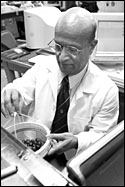Preserving India's food
"Give a man a fish and he will eat for a day, teach a man to fish and he will eat for a lifetime," the old saying goes. But solutions to the problem of world hunger aren't that simple. Knowing how to fish or produce food successfully is only half the battle.
 Professor Vijaya Raghavan
Professor Vijaya RaghavanPHOTO: JEAN-FRANÇOIS MAJEAU |
|
For the past two decades, India has had the know-how and technology to produce high-yielding crops and, especially in fertile states such as Karnataka, this technology has been rather successful.
However, the problem in India, where 60% of the economy is dependent on agriculture, is the inability to preserve agricultural surpluses. According to a 1999 World Bank Report, post-harvest losses amount to 12 to 16 million metric tons of food grains each year -- an amount that the World Bank stipulates could feed one-third of India's poor.
Professor Vijaya Raghavan, chair of the Department of Agricultural and Biosystems Engineering, has been tackling this problem in India for the past 10 years. In partnership with a South Indian university in the state of Karnataka, Raghavan ventured in the early 1990s to improve post-harvest research and education in South India.
Last week, Clifford Lincoln, Member of Parliament for Lachine-Lac St. Louis, visited Macdonald Campus to announce that the Canadian International Development Agency (CIDA) will contribute $5 million to expand Raghavan's project targeting food security in South India.
According to former Minister for International Cooperation Maria Minna, "This CIDA funding is a good example of how Canada will help reduce by one-half the proportion of people living in extreme poverty." An ambitious goal on CIDA's part. But Raghavan's strategy is simple and straightforward: to strengthen post-harvest education and research at selected South Indian universities.
"It is not just about transferring Canadian technology," says Raghavan. "We give them the tools to analyze problems and solutions at the local level."
In 1991, recognizing the void in research and development in the area of post-harvest technology, Raghavan worked with the University of Agricultural Sciences (UAS) in Bangalore in the state of Karnataka to establish programs in agricultural and post-harvest engineering.
A native of Karnataka himself, Raghavan had to come to North America in order to do his graduate studies -- suitable programs just weren't available in India. Thanks to his project, students of Karnataka are now able to obtain bachelor's and master's degrees in agricultural and post-harvest engineering from their state university.
The CIDA funds will allow Raghavan to extend his work to two more South Indian universities: the Tamil Nadu Agricultural University in Coimbatore, Tamil Nadu, and the University of Agricultural Sciences in Dharwad, Karnataka.
"Our main thrust is the village," Raghavan explains when asked how his project will directly affect the poor of India. In order to carry out its research, the UAS has adopted a "model village" in the state of Karnataka. Low-cost post-harvest techniques were developed by the staff and students of the UAS and subsequently promoted in the adopted village as well as several other villages through a series of demonstrations and on-site training sessions.
Such "lab-to-land" schemes have enabled the UAS to transfer their scientific findings to the farming community of Karnataka. "We want farmers at the lower end, small-scale farmers to take charge of their problems," says Raghavan.
"We learned a lot about the infrastructure and needs of the farming community around Bangalore during the first project," says Raghavan. "The new project is much broader in scope; we want to build on the success of the previous collaboration to consolidate food security in two key states, Tamil Nadu and Karnataka." The two states represent 60% of the South Indian population.
When discussing the achievements of his previous project in India, Raghavan points to the establishment of biogas, a harmless and simple means of generating electricity in rural Karnataka. Cow and buffalo dung, as well as human and poultry excreta, are used as raw material for the production of biogas. The major components of this renewable source of energy are carbon dioxide and methane.
The engineering staff of the UAS has installed biogas plants at several farms enabling villagers to derive electricity for basic lighting, heating and cooking at no cost in previously un-electrified areas. They hope to extend the use of biogas for agricultural uses such as pumping water and killing insects.
Raghavan says that there is no mystery to much of food preservation - it's just a matter of having the suitable technologies in place and the people on hand who have the ability to implement them and train others.
"In India, post-harvest losses of fruits and vegetables range from 20 to 40%, while losses in pulses, oilseeds and cereals range from 10 to 30%. This represents a market value of approximately $15 billion U.S. per year, causing a serious dent in the economic wealth of the farm producers.
"India's internal market for fresh produce is immense, but in many instances the market cannot sustain the large inflow of produce leading to a market glut, panic selling and drastic drop in sell prices and product losses.
"These losses can be prevented with simple post-harvest practices such as rapid removal of field heat, cleaning, evaporative cooling, refrigerated storage, wrapping, drying, pickling, preserving, etc.
"The fruit and vegetable sector could significantly benefit from infrastructural support such as cold storage chains, refrigerated transport facilities, centralized food processing facilities and so forth."
Judging from his track record, Raghavan himself can be expected to supply some novel approaches to food preservation in the future. He perfected microwave-vacuum drying, a quick method for dehydrating food, and his team is pioneering new techniques aimed at cutting down on the use of chemicals to remove disease from seeds, using a radio frequency instead to heat seeds rapidly without removing their ability to germinate.

